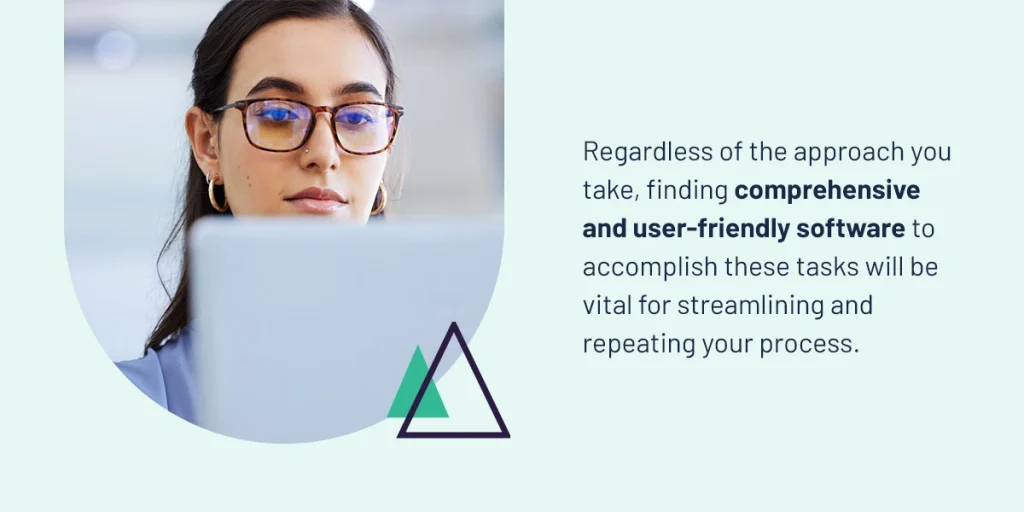
A curriculum map can be an incredibly useful tool in identifying opportunities for continuous improvement in your academic offerings. Curriculum mapping is one of the best ways to ensure teacher effectiveness in today’s data-driven world.
Here’s a look at how to utilize a curriculum map effectively for improving learning outcomes and enhancing the student experience.
The importance of leveraging curriculum mapping
A curriculum or course alignment map illustrates where educators can address and teach student learning outcomes. This process allows higher education institutions to identify gaps and provide opportunities for improvement. Although curriculum mapping offers immense benefits for students, colleges and universities can also use this process to meet institutional needs and objectives. This process empowers decision-makers to align curriculum with institutional standards, find assessment opportunities, and plan a sequence for instruction to provide the most value to each student.
The 4 components of curriculum mapping
There are many useful ways to build out your curriculum map. While the curriculum maps are dynamic in nature, they are typically comprised of four main parts:
- Intended outcomes: The set of outcomes you are seeking to meet with this program (the y-axis along the left side).
- Alignment: The courses aligned to the curriculum for that program or course (the x-axis across the top).
- Outcome classification: Tags to indicate the nature of an alignment — whether a given course introduces, reinforces, or enables a student to master a particular outcome.
- Assessment: Alignments to the specific measures used to assess the outcome in a given course.
In these examples, you can see where the outcomes are being introduced, reinforced, and mastered in the courses listed on the left, as well as where there is an associated assessment activity to measure outcome achievement.
Using keys to evaluate course outcomes and identify gaps
Using comprehensive software like Watermark Planning & Self-Study, you can create unique curriculum maps. Every curriculum map you create in Planning & Self-Study comes with a default key that classifies learning outcomes into three levels:
- Introduced: Students learn core concepts of their discipline in the classroom and can demonstrate a basic ability to apply that information in the real world.
- Reinforced: Students practice and deepen their understanding of introduced concepts, expanding their abilities to use their knowledge within the field.
- Mastered: Students can demonstrate mastery and proficiency in the knowledge and skills they have learned throughout their course of study.
These classifications provide a bird’s-eye view into the overarching story of your data. They enable you to easily determine how each course fits into your overall curriculum and the order in which each course should be taken.
The visual element of a curriculum map can also reveal where learning gaps exist, which can facilitate discussions about potential areas for refinement or optimization. For example, you may discover that students in your nursing program are missing opportunities for reinforcement of new concepts that have become essential in the field.
How to align course content to learning outcomes
Learning how to use a curriculum map is a straightforward process with the right software at your disposal. The process for aligning outcomes and course content usually follows this process:
- Classifying all courses and cocurricular learning experiences according to their level within the program.
- Using a software program to create a curriculum map that includes all of the above data.
- Examining the curriculum map within a group or committee.
- Identifying opportunities to cover gaps within the curriculum as well as ideal points for further assessment.
As your institution’s decision-maker, you understand your unique needs better than anyone else, and you may need to adjust this process to find the best solution for your students and institution. Some other tips for aligning course content with learning outcomes include:
- Consider your mission: Before designing any objectives, you should consider the overarching goal of your program. For instance, if you’re redesigning General Education courses, you should revisit learning outcomes specified for the content of each class and familiarize yourself with the unique learning outcomes necessary for accreditation.
- Determine what students will take away: Using a “backward” approach, you can determine what you want students to take away from a program and build content to support this end goal. You can always revisit this concept any time you want to introduce additional course content or need to redesign modules to reflect up-to-date industry standards.
- Make measurable objectives: The more data you have to work with, the more informed your decisions can be. Each of your objectives should be measurable so that you can evaluate the strengths and weaknesses of your strategies and make data-based changes to drive growth and enhance student success.

Regardless of the approach you take, finding comprehensive and user-friendly software to accomplish these tasks will be vital for streamlining and repeating your process. The Planning & Self-Study platform makes it easy to affiliate courses and outcomes in just a few clicks. You can also choose the Introduce, Reinforce, and Master labels to indicate the value of alignment for each course. And after taking an action, your curriculum map will automatically update to reflect your changes.
Analyzing learning outcomes
Planning & Self-Study supports analysis of two types of outcomes:
- Learning outcomes: These are the skills and knowledge students develop through participating in classroom education and cocurricular learning experiences. Institutions typically measure learning outcomes through formative assessments such as capstone projects, quizzes, performances, and exams.
- Success outcomes: These are non-academic measurements that track the effectiveness of continuous improvement initiatives for accreditation and internal reporting. They can also help determine the success of non-instructional efforts such as enrollment and retention.
Individual programs can also link course assessments in the curriculum map to provide additional depth. Faculty and staff can use this information to gain clear insights into how each course fits into the program’s overall goals for students.
You can also use this map to determine the best points for program assessments. Faculty can review and manage exactly where these assessments take place as well as the extent to which student efforts within each course contribute to achieving the intended outcomes — which will help assessment professionals plan future evaluations and collect data more effectively.
How this approach can help you meet higher education needs
One of the most significant benefits of curriculum mapping is finding a straightforward way to align your institution’s content with institutional goals, educational standards, and mission statement. For example, you may need to meet specific curriculum standards to meet accreditation agency requirements, and curriculum mapping empowers you to stay on track and find additional growth opportunities.
You can also use a curriculum map to meet other institutional needs and goals, such as:

- Student retention: Many institutions aim to increase retention to highlight their ability to shape students into leaders and innovators. High retention rates are profitable for colleges and universities and provide benefits like saving money, measuring success, and identifying at-risk students. Mapping your curriculum empowers you to take a student-centered approach to education. By identifying student needs and addressing issues within your programs, you can design more coherent courses that offer unique and purposeful learning experiences that your students find valuable.
- Career placement: Higher education aims to prepare students for life after graduation, including career placement. You can use curriculum mapping to connect programs to occupations to increase success rates. Along with providing worthwhile experiences to students that prepare them for a successful future, you can use this data to highlight your institution’s success and stand out among competitors.
- Data collection: Curriculum mapping empowers you to gather comprehensive data to aid in decision-making. Whether you need to gather data regarding retention rates, enrollment, program success, accreditation requirements, or something else, you can use this process to monitor success and identify areas for improvement. Applying data-driven insights drives more efficient operations, minimizes setbacks and risks, and improves student success.
The goals you can meet with curriculum mapping do not stop here. Your institution is unique and aims to complete unique objectives. Thankfully, curriculum mapping is an excellent solution for meeting a plethora of higher education needs, and the process offers the flexibility you need to satisfy your college or university. With the right tools, you can drive growth at your institution and create a culture of continuous improvement.
Use curriculum mapping to improve outcomes at your institution
Institutional use of curriculum maps allows faculty, administrators, and other stakeholders to see the bigger picture of assessment activity and the alignment of assessment efforts across campus to identify gaps and help with planning.
Overall, creating a curriculum mapping process that involves producing curriculum maps can be a useful — and satisfying — way to make the assessment process more engaging for your faculty and staff. You can use it for any set of program outcomes, institutional goals, or accreditation standards for which you need a visual supplement.
Discover how Watermark’s assessment and accreditation software solutions can streamline your curriculum mapping and assessment process by requesting a demo today.















































































































































































































































































































































































































